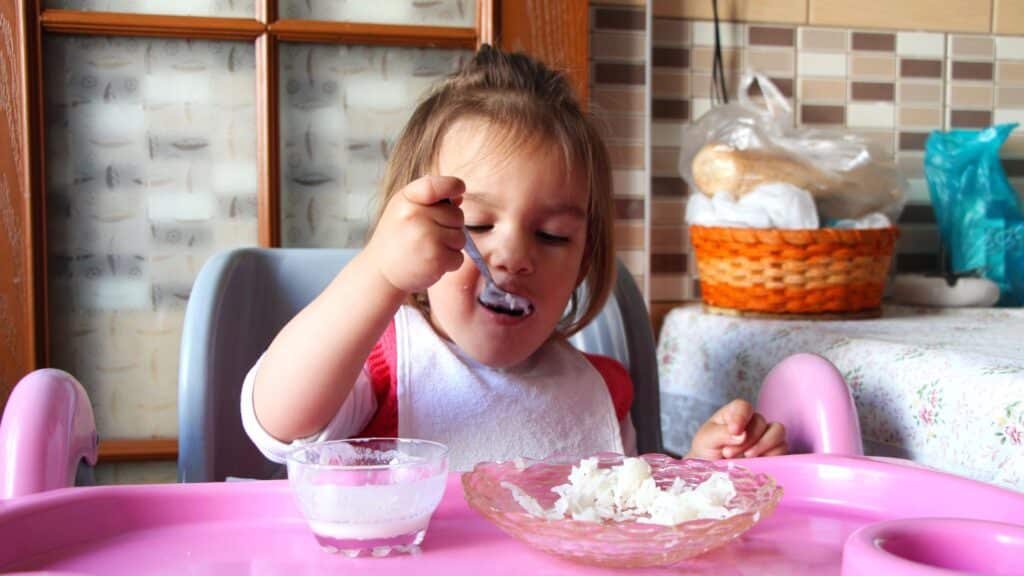Weaning is one of the most exciting parts of raising a child but it can also be a little scary. You’re leaving behind one solid source of nutrition and moving on to a new one, which means new risks and responsibilities.
But how do you know when it’s time to start? And how do you know how much water to give? We’ve got answers to all those questions and more in this new mother’s guide on successful weaning.

Signs That Your Baby Is Ready to Start Weaning
Weaning is a significant step in a baby’s life and should not be delayed. The American Academy of Pediatrics recommends exclusive breastfeeding for the first six months, after which you can start introducing solid foods while continuing to breastfeed. Signs that can help determine when to start weaning include the baby’s age, weight, and interest in solid food, as well as the mother’s milk supply.
Babies may show an interest in solid food at different times, so mothers should pay attention to their baby’s cues. If the baby is gaining weight at a healthy rate but still needs supplemental nursing or formula feeding, weaning them off these liquids can be considered. If the mother is producing less breast milk, it may be time to wean or supplement with formula or expressed breast milk.
It is essential to note that weaning is a natural process that can happen gradually. As the baby’s immune system strengthens, they become less reliant on human milk and can tolerate whole cow’s milk.
Mothers may have mixed emotions about weaning, but it is a natural progression in the baby’s development. Some mothers may choose to continue breastfeeding for comfort or bedtime feedings while gradually reducing the frequency of breastfeeding sessions.
If you’re one of the many breastfeeding mothers out there, you might be wondering when to start weaning. The World Health Organization recommends breastfeeding exclusively for the first six months of your baby’s life, but after that, you can start introducing solid foods.
It’s important to remember that weaning doesn’t have to happen all at once. You can start by replacing one nursing session with solid food and gradually work your way up. This will also help your baby get used to the taste and texture of new foods.

For those who choose to use infant formula, weaning can be a little different. You’ll still want to replace nursing sessions with formula, but you’ll also need to make sure your baby is getting enough water. As your baby gets older, it’ll need more water, so be sure to talk to your pediatrician about how much to give.
If you have an older baby, you might be wondering if it’s time to wean sooner rather than later. Every baby is different, but most babies will naturally start to lose interest in nursing as they get older. You can also try cutting back on nursing sessions and seeing how your baby responds.
Remember, weaning is a process, and it’s important to take your time. With a little patience and perseverance, you’ll help your baby transition to solid foods with ease.
How To Start Weaning?
Weaning is the process of introducing solid foods to your baby. It can be a delicate process, but you can do it successfully with the right tools and knowledge.
To start weaning, you need to have a plan. Here’s a quick checklist:
Slowly Introducing Water
When you’re going through the weaning process, it’s important to take your time and introduce your baby to water slowly. You don’t want to dump a bunch of water in their mouth immediately!
The first step is to give them a small amount of water mixed with milk or formula. This will help them get used to the taste and texture of liquid. Next, try giving them more water mixed with milk or formula, but only add a little water until they’re used to it. Then you can try giving them plain water without any mixed milk or formula!

Gradually Reducing Breastfeeding Sessions
Nursing mothers who are ready to start weaning their babies can do so by gradually reducing the number of feedings. This can be achieved by reducing or spacing out care sessions per day.
First, the mother reduces her breastfeeding frequency to one per week and gradually increases the weekly frequency until the baby is breastfeeding only two or three times per day. increase. Once the baby is breastfeeding her only a few times a day, the mother can space her feedings.
When the time comes to stop breastfeeding, the mom can replace her one breastfeeding session with one bottle of feed per day. You can then gradually reduce the number of bottle feedings until your baby only breastfeeds during night sleep.
Gradual weaning helps make the process smoother for both mother and baby. Reduced risk. Mothers should also remember that weaning is a natural process and can cause mixed feelings both for themselves and the older child, but it is a necessary step in the baby’s development.
Offering Solid Foods
Offering solid foods is a great way to get your baby to begin eating on its own and an important step in the weaning process. However, it’s important to remember that offering solid foods does not mean you’re weaning your baby. You can still breastfeed or bottle-feed them before bedtime and at other times throughout the day.
The best time to start offering solids is around 6 months old. Your baby will start showing signs of readiness for solid foods at this age, such as sitting up on his own and taking an interest in what you eat.
When starting solids, make sure you’re using small portions and introducing one new food at a time so you can determine if there are any allergies or sensitivities that may cause problems later on down the road.
If you’re unsure about how much food your baby needs each day or how often they should be eating solid foods, speak with your pediatrician so they can help guide you towards making healthy choices while also ensuring they’re getting all the nutrients they need to grow properly!

Choosing Appropriate Cups
The best cups have handles and are easy for babies to hold. They should also be sturdy and not leak, so they don’t get everywhere when they fall over.
You can also try using sippy cups, which are designed with an open top that allows milk or water to come out when the baby sucks on the spout.
These types of cups are great for weaning because they mimic breastfeeding and help babies learn how to drink from a cup without having any milk spill out of their mouths.
Reducing Breast Milk Feedings
You can reduce your breast milk feedings by one every day or even by half. The goal is to help your baby adjust gradually, so they don’t experience stomach issues or emotional trauma.
It’s also important to talk with your doctor before reducing your breast milk feeds, so they can ensure everything is going smoothly.
Adjusting To the New Routine
When you decide to wean your baby, you can expect that your routine will change. You will have to get used to this new routine, and some of it might not be easy at first. But don’t worry, because you will get used to it in time!
Some of the things that might happen when you start weaning your baby include the following:
- You may need to wake up earlier than before because babies tend to sleep longer when they are weaned.
- Your baby might have less energy, so they may not want to play as much as they used to. This is normal, but if this happens for over two weeks, you should talk with your doctor about it. If this happens for over two weeks, you should talk with your doctor about it.
- If you are breastfeeding, then your supply of breastmilk will decrease significantly once you stop breastfeeding entirely.
Adjusting to the new routine is not easy, especially when you have a lot of things to do and are not used to it. You must take your time and try to make everything as easy as possible for yourself. This way, you can enjoy your free time and rest simultaneously.

Here are some tips for making sure you’re ready for school:
Scheduling Regular Water Breaks
Schedule regular water breaks. You must give your baby plenty of water, so they don’t get dehydrated during this process. Ensure that there is always a fresh bottle of water in the fridge or on hand for them to drink whenever they want it. This will help prevent any accidents from happening because they’re thirsty!
Offering Healthy Snacks and Meals
It’s important to offer healthy snacks and meals. Healthy snacks include:
- Fruits and veggies.
- Yogurt.
- Cheese sticks.
- Whole grain crackers or breadsticks.
- Nuts and seeds.
- 100% fruit juice with no added sugar.
Healthy meals include a lean protein such as chicken breast or tofu, whole grains such as brown rice or quinoa, and plenty of nutrient-rich vegetables like broccoli or spinach.
By offering healthy snacks and meals throughout the day, you’ll be helping your baby learn how to eat healthfully while they wean off of breastfeeding.

Strategies for Dealing With Resistance or Setbacks
Weaning your baby is a challenging transition, but it doesn’t have to be painful. Here are some strategies for dealing with resistance or setbacks during this time.
1. Be patient. It’s normal for babies to resist weaning and try to hold on to their bottles as long as possible. Don’t take it personally! It’s just that they’re finally growing up and becoming more independent, which you should be proud of, not frustrated by.
2. Make sure you have enough support around you so that you don’t get overwhelmed by the process of weaning your baby or the resistance they might put up when it comes time for them to give up their bottle entirely.
3. Try using a pacifier instead of a bottle until they get used to not having something in their mouth all day long (this can take anywhere from one week to several months. If your baby is resistant because they’re not ready yet, try again later on down the road once they’ve adjusted better emotionally too.
Final Steps in the Weaning Process

If you want to stop breastfeeding your baby, it’s important to do it in a way that will be comfortable for you and your child. Here are some of the final steps in the weaning process:
Phasing Out Breastfeeding Sessions
You can phase out breastfeeding sessions gradually, depending on your baby’s needs and your own.
For example, if breastfeeding at night, you might want to wean your baby off those nighttime sessions first. Or if you are both ready for the change, you can do it all at once.
Gradually Increasing Water Intake
The best way to do this is by adding one teaspoon of water to her formula daily until she drinks a full cup of formula with no water added. Once you’ve reached that point, you can switch from formula to whole milk.
Celebrating the Successful Transition
This is one of the most exciting moments of your baby’s life: the transition from breast milk to formula. It’s also a time to reflect on how far you’ve come and to take pride in what you’ve done together.
Don’t forget that this is just one part of your journey as a parent. Every day brings new challenges and opportunities for growth, so try to stay positive and keep moving forward!

Takeaway
Weaning your baby off breast milk can be a delicate process, but you can do it successfully with the right tools and knowledge. Signs that your baby is ready to start weaning include age, interest in solid foods, weight gain, and decreased milk production.
To begin weaning, it is important to have a plan. You should gradually introduce water and solid foods, reduce breastfeeding sessions, and choose appropriate cups. It is also important to adjust to the new routine while keeping in touch with your doctor.
Successful weaning requires patience, persistence, and commitment, and it’s important to remember that every baby is different, so it’s okay if the process takes longer than expected. With time, your baby will adjust to the new routine, and you’ll be able to feel proud of the successful weaning.
If you have any questions, please feel free to ask them in the comments section below.



